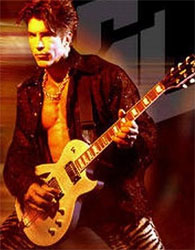Lynch’s ’95-Era Gear: Live Rig
Part 2
In effort to get to the bottom of what George Lynch used in the studio on the cut “Lesser of Two Evils,” here’s a rundown of the live gear he used on that tour (also from an older version of his site), which may give a clue about his studio setup.
Amps
> 100-watt Mesa/Boogie Dual Rectifiers
> 100-watt Fender Tone-Masters
> 50-watt Peavey Classic 50 heads
> Fender Twin Reverbs
> The main workhorse of the rig was the Dual Rectifiers. Interesting to note about these amps is the uniqueness of this version. In 1989 Mesa/Boogie began developing a much higher-gain amp featuring a dual-rectifier tube design. By 1990, productions on the first run of these amps were handmade and, because of the nature of a first-run production, featured a host of components that do not match current production models. And different machined power transformer than the standard production model was installed in the first 500 amps, making them much more aggressive in tone and in the gain structure.
> Cosmetically, these Dual Rectifiers look different, featuring black silk-screened graphic logos and amp control labels on a mirrored chrome faceplate
> Used in conjunction with the Mesa/Boogies was the Peavey Classic 50. This seemingly vintage-ish looking amp carries a much higher gain than most Class A amps of this type. Housed inside the chassis is a two-EL34 power section with three 12AX7 preamp tubes. It’s a simple amp yet a monster. (George used this amp to record his solo on “People Get Ready†on the Jeff Beck tribute album, at The Power Station in NYC).
> The Fender Tone-Master amps are hand-built at the Fender Custom Shop in Corona, CA. The Tone-Masters on that tour are point-to-point soldered and [have] four 6L6 vacuum tubes. George used these for searing tone with his Fulltone pedals in-line.
> While those three amps carried most of the show, the Fender Twin Reverb was used for George’s glassy clean tone in various songs during the set.
Effects
> Effects were on the floor and running in line.
> George used Fulltone pedals as he did in the studio during the recording. The same ones – 69 pedal, Octafuzz and Dejavibe – ran in-line to the Tone-Masters.
> The Boss DS-1 Distortion was employed much like the Ibanez Tube Screamer in past tours, as an overdrive to push the signal harder into the amp’s inputs. The distortion setting is kept to a minimum while the level control [pushed] the amp’s gain a little more over the top during solos.
> A Boss CE-5 Chorus ensemble thickened the signal a little more and was used to split the signal.
Electric Guitars (all ESP)
> Haji (Skulls & Snakes)
> Serpent
> George Paul (the custom ESP rendition of a ’59 Les Paul a la George)
> ESP Ultratone
> 2 Vintage + S models (one with the Fishman Power Bridge for the acoustic set in the show)
Acoustic Guitars
> Martin GT-16 (used on “Nothing Left To Say” and the intro to “The Maze”)
> ’63 Gibson Hummingbird, later stolen
Signal Chain
> Guitar, Y at a Whirlwind A/B switcher, splitting or combining a Tone-Master either alongside or separated from the Dual Rectifier and Peavey Classic, used in tandem.
> When switched to the A signal of the switcher, the guitar’s signal is split at the Boss CE-5 Chorus, going in stereo to the Dual Rectifier (dry) and to the Peavey Classic (wet).
Bottom Line
Sounds to me like the studio tone would be the Peavey (George loves to use something all the time when he falls in love with it) and Tone-Master, maybe the Marshall too – I think I’m hearing more than one amp there – plus at least the Boss DS-1.
Bottom line is this is still one of my favorite tunes by this band. I’m a big George fan, I like Mick Brown’s heavy sticks, Jeff Pilson is just all-around good (good background vox too) and Don Dokken…well, either you can get along with his voice or you can’t. Doesn’t bother me – I’m listening to the guitar – but some buds of mine can’t take it.
Category: Boss/Roland, ESP, Fender, Fulltone, George Lynch, Gibson, Ibanez effects, Martin, Mesa/Boogie, Peavey














